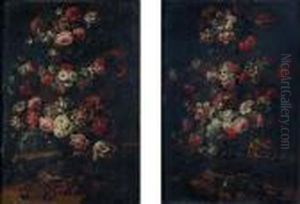Gaspard Verbrugghen Ii Paintings
Gaspard Verbrugghen II was a Flemish painter known for his contributions to the Baroque movement, particularly in the realm of still life and floral compositions. Born in 1664 in Antwerp, he was part of a family deeply entrenched in the arts. His father, Gaspard Verbrugghen the Elder, was also a respected painter, providing a creative and stimulating environment for the younger Verbrugghen's artistic development.
Verbrugghen II's career was primarily centered in Antwerp, a city that was a significant cultural hub in the 17th and early 18th centuries. Here, he became a master in the Guild of Saint Luke by 1685, a testament to his skill and reputation in the artistic community. His work is characterized by its intricate detail, vibrant colors, and the dynamic interplay of light and shadow, hallmarks of the Baroque style that sought to evoke emotion and movement.
His still lifes often featured elaborate floral arrangements, sometimes accompanied by fruits, insects, and other elements that added layers of meaning and symbolism. These compositions were not only celebrations of nature's beauty but also contained moral or vanitas themes, reflecting on the transience of life and the inevitability of death. Verbrugghen's ability to render textures and surfaces with high realism made his paintings highly sought after by collectors and patrons, including members of the aristocracy and the Church.
Despite the popularity of his work during his lifetime, Gaspard Verbrugghen II did not achieve the same level of lasting fame as some of his contemporaries. However, his contributions to the development of Flemish Baroque painting, particularly in the genre of still life, have been increasingly recognized and appreciated in more recent years. His paintings can now be found in several important museums and private collections around the world. Gaspard Verbrugghen II died in 1730, leaving behind a legacy of artistic achievement that continues to be celebrated for its beauty and technical mastery.
